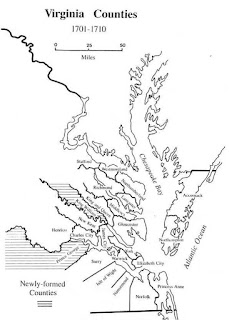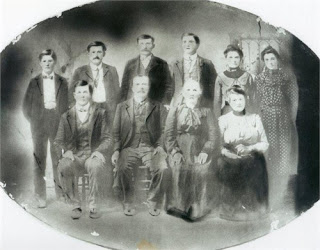The Gilliam In-Laws: Back to Virginia, Part 1
So far in this blog, we have covered the Gilliam line from their first steps in the New World in 1635 and followed them as they migrated across the country. Those posts have taken us from the Virginia Colony to Tennessee, then to Arkansas and Texas and Oklahoma. Before we follow the next generation of Gilliams from Oklahoma to California, I want to go back and discuss the women married to the Gilliams in our direct line and their families. Some of those families are not as well documented as the Gilliam line, but I will try to provide whatever evidence we have of our "great" grandmothers.
In this post we will start with the women who married John Gilliam (1613-1673) (my generation's ninth great-grandfather), and his son Hinchea Gilliam (1663-1734) (my generation's eighth great-grandfather), both of whom stayed in the James River Basin of Virginia.
In a prior post "Why are there so many Hinchea Gilliams?" we discussed Margery (my generation's ninth great-grandmother), the woman that married the first Gilliam in the New World, John Gilliam. The evidence is unclear on Margery's maiden name or her background, but she has been the subject of much speculation. Much of the speculation is centered on the fact that she and John named one of their sons Hinchea Gilliam, who happens to be the next Gilliam in our direct line. "Hinchea" became a name that Gilliams gave their sons for several generations thereafter. Indeed, researchers have found that John and Margery's daughter, Elizabeth Gilliam Maybury, started a similar tradition in the Mabry family (the family later shortened the name) by naming their son Hinchea. That tradition of "Hinchea Mabry" lasted for five generations of Mabrys. The unusual name used in both branches of the family led to the speculation that Margery's maiden name was Hinshaw, or Henshaw. There were contemporaneous settlers in the Virginia Colony with that name, including William Henshaw, one of the passengers that came to Virginia in 1635 with John and his brother Thomas on the ship George. However, no one has found definitive proof of the connection. Even if we assume the speculation is fact, there is not much to go on to tell us how Henshaws got here or where they came from. After John died, Margery married again but had no additional children. She and her second husband, Henry Briggs, remained among the more prosperous members of the Virginia Colony until her death in 1688. Her will was probated in Surry County on October 20, 1688 and she left her estate to be divided among the children she had with John Gilliam, all of whom stayed in the Virginia Colony: John, Hinchea and Elizabeth.
Like Margery Gilliam Briggs, there is speculation regarding the wife of her son Hinchea, the wonderfully-named Fortune Flood (1678-1753) (my generation's eighth great-grandmother). Based on my research, Fortune Flood was the daughter of Walter Flood (1656-1722) and Anne Browne (1661-1723). Walter Flood's parents were John Fludd (later changed to Flood) (1595-1661) and Fortune Jordan (1623-1669). Anne Browne's parents were William and Mary Browne. Mary Browne's parents were Henry Browne and Anne Fowler. The Floods and the Brownes were prominent members of the Virginia Colony and form a significant part its genealogical history.
Some genealogists dispute the evidence that Fortune was a Flood, based on the fact that some of the wills of members of the Flood family refer to a "Fortune Flood" even after Fortune married Hinchea. Because she would have changed her surname at the time of her marriage, they believe that if she was Fortune Gilliam, those wills would have named her that way. However, several of the Flood siblings named a daughter Fortune, and it appears the confusion is caused by the several cousins named "Fortune Flood." I think the evidence weighs in favor that Hinchea Gilliam married Fortune Flood, the daughter of Walter Flood and Anne Browne.
Fortune Flood's grandfather, John Flood (my generation's 10th great-grandfather) is the earliest-arriving North American immigrant of our ancestors I have found to-date. John was still in his teens (he is believed to have been born sometime between 1591 and 1595) when he arrived on the ship the Swan (sometimes spelled the Swann) at the Jamestown Colony in 1610. In the winter of 1609-1610, the Jamestown colonists were experiencing what was later called "The Starving Time" as their numbers dwindled from 500 to about 100 survivors. The Swan arrived in August of 1610 with two other ships (the Tryall and Noah, all under the command of Sir Thomas Gates). With their supplies of food and additional settlers, along with success at planting a better strain of tobacco for export, the colony finally began to prosper.
To place John Flood's arrival at Jamestown into some historical context, his 1610 arrival was ten years before the Pilgrims left England in 1620 on the Mayflower. He arrived three years before Pocahontas was captured by the Jamestown colonists and before she would later marry fellow Jamestown colonist John Rolfe. John Flood was later appointed to be one of the Colony's interpreters with the Native American tribes, served as a Burgess in the Colony's government and was named as one of Virginia's Ancient Planters. John Bennett Boddie, author of Southside Virginia Families, described him this way: "John Flood was only a boy when he came to Virginia, but he was active and energetic and rose to high honors."
John's second wife (my generation's 10th great-grandmother) was Fortune Jordan. Not much is known regarding her parents, but she is believed to have immigrated from England with or following her brother, George Jordan, who arrived in 1634 or so. She married John Flood around 1645 and had two children with him, Jane (1646-1669) and Walter (1656-1722).
The Jordans were also prominent members of the Jamestown Colony. Fortune Jordan's brother George was a planter who served in the Virginia House of Burgesses and also as Attorney General for the Colony. Their brother Arthur was also a respected planter.
Fortune and John Flood's son Walter (1656-1722) (my generation's 9th great-grandfather) married Anne Browne (1661-1723) in approximately 1677. Little is known about Walter's life except that after his John Flood's death in 1661 or so, Walter was placed in a guardianship with two of John's attorneys to assure his later education in England. Walter completed his education and the guardianship was released in 1677, about the time he married Anne Browne.
Like the Jordans, the Brownes were prominent plantation owners in the Jamestown Colony. Anne's grandparents were Henry Browne (my generation's 11th great-grandfather) and Anne Fowler who established the Four-Mile Tree plantation in 1637. He received a total of 2250 acres, including 250 that had been owned by Captain John Smith. The plantation stayed in the Browne family for several generations. A portion of the plantation still exists today and was most recently sold in 2014 for $1.4 Million.
Henry and Anne Browne's daughter Mary was married to William Browne (thought to be a cousin). He was an officer in the militia, rising to the rank of Colonel. He also served as Sheriff of Surry County. Their daughter Anne married Walter Flood in about 1677. Anne and Walter Flood's daughter Fortune married Hinchea Gilliam in about 1695. Hinchea Gilliam and Fortune Flood Gilliam had nine children: Charles, John (my generation's seventh great-grandfather), Hinchea, Walter, William, thomas, Mary, Lydia and Priscilla. It is believed all of their children stayed in the James River Basin of Virginia throughout their lives.
The next post will pick up with the last two generations in Virginia, John Gilliam's grandson John Gilliam (1696-1738), and his great-grandson Hinchea Gilliam (1718-1794).



Comments
Post a Comment